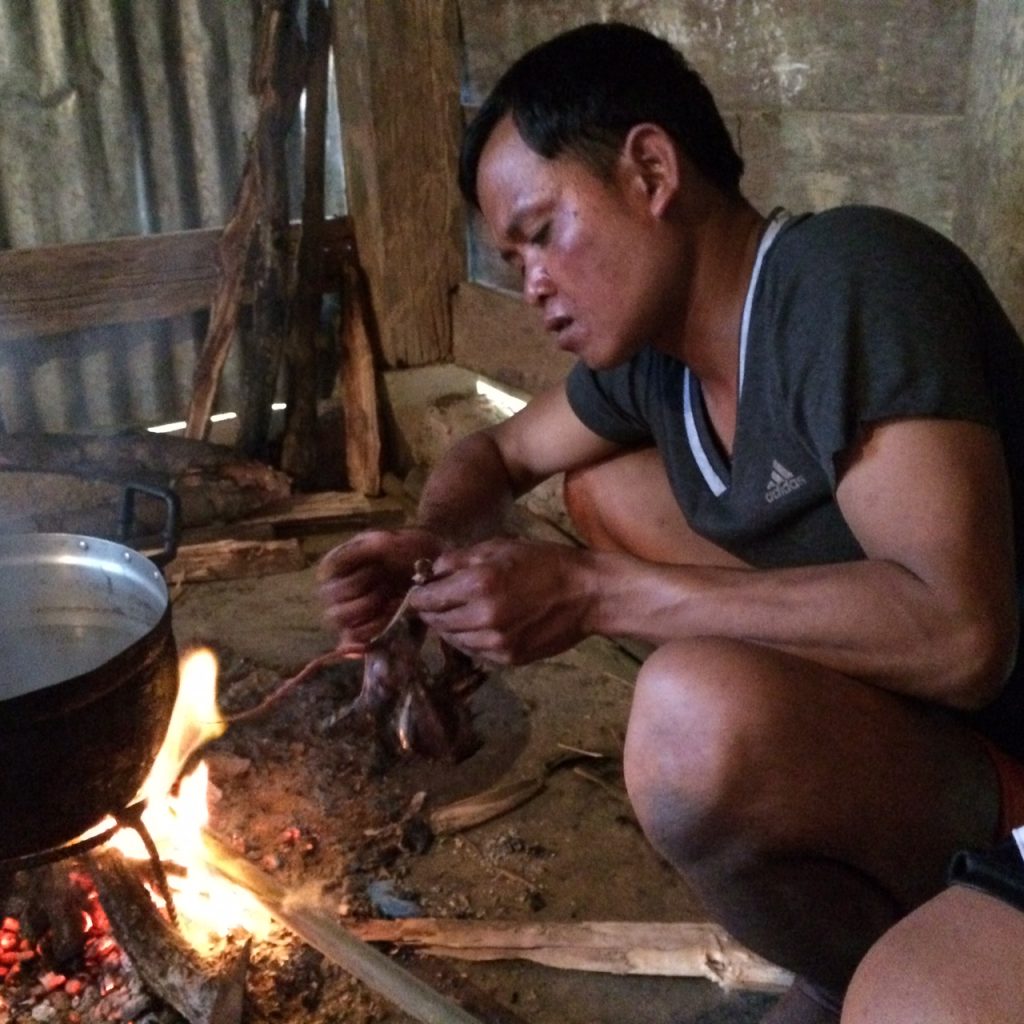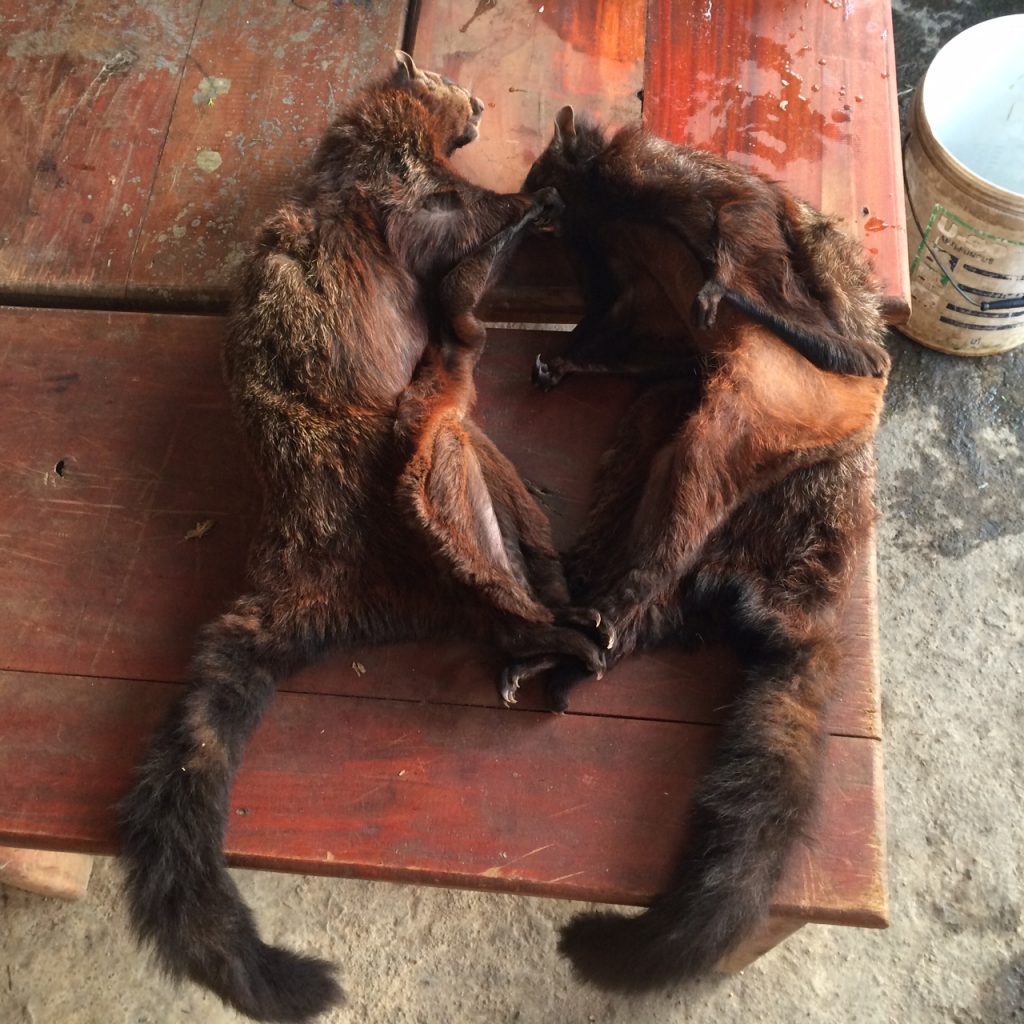Lao Camp Food (Part 2)
This is the second installment of a food journal I kept during several days in February camping with a bomb clearance team in Laos. If you missed my previous post, please see Lao Camp Food (Part 1).
The presence of a bomb clearance team in a small, remote village near the Laos/Vietnam border in Sekong province gave a little jolt to the local economy. Every morning, and sometimes in the evening too, a village hunter would arrive with bush meat, and the team enthusiastically bought it. On offer were bamboo rats, squirrels, and other small animals caught in the surrounding jungle. The carcasses went straight into the kitchen and were systematically gutted. Fur was burned and scraped from hides, to a hideous stench. Most every piece of every animal was used—blood, offal, tripe, and even bile, a bitter ingredient common in laap and soup. Some of the bones were soaked in lao lao, the local whiskey. The camp kitchen resembled “an orgy of killing,” as one team member remarked. But nose-to-tail eating wasn’t a mere aspiration; it was custom and canon.
Wild animals are a critical part of the village diet in Laos—especially in Sekong, where food is frequently scarce. “There is severe malnourishment,” says Alison Rusinow, program director for CARE, “and Sekong actually has the highest stunting rates in Laos.” Most rural mountain households don’t have enough rice for the year, and they have very few sources of protein. “The main source, really, is from the forest,” she says. Rodents, birds, and insects all make regular appearances on the rural Lao table.
But wildlife is also a source of income—increasingly so in the international trade of endangered species, both for food and traditional medicine. It’s a business driven not by hunger so much as a growing urban elite population. “Wealth—not poverty—drives the wildlife market,” according to Rhett Butler, founding president of the environmental group Mongabay. For example, the last remaining jungles stretching between Laos and Vietnam still shelter a few dozen tigers. The 25 pounds or so of bones from an adult tiger reportedly can sell for US$12,000 to $15,000. That’s an enormous sum for villagers who earn just a few hundred dollars a year. Some of it stays in the region; some of it feeds into the lucrative underground market in wildlife trafficking. “Every year tens of millions of wild birds, mammals, and reptiles are killed to supply multi-billion dollar markets in China, the United States, and Europe,” Butler reports.
The vast sums of money involved make this trade particularly difficult to stop. Establishing wildlife-protection programs and arming park rangers with guns isn’t the sole solution, Rusinow says. “You need to give people the solutions that they need to have the food that they need to have the income that they need so that they don’t need to go and kill those animals anymore.”
That’s why her group is helping villagers to build fishponds, raise livestock, and plant cash crops on land cleared of bombs. The primary hope is to provide nutritious food for malnourished villagers. At the same time, they also want to build a local economy that will help keep the forest intact. But first, all farmlands must be cleared of bombs—which is why CARE works with the U.S. nonprofit We Help War Victims to bring clearance teams into remote villages and fields in these rugged mountains near the Vietnam border.
Even so, even after fields are declared free of bombs and safe to plant, villagers will hunt when an attractive market makes itself available—even if that market is just a clearance team temporarily camping nearby.
One day, shortly after sunrise, a woman arrived in camp with two furry creatures I’d never seen before. They were between 2 and 3 feet long with thick rust-colored coats, bushy tails, black eyes, and furry winged flaps. Everyone called them “flying foxes,” and the camp kitchen had seen several of these critters in recent weeks. Their parts ended up in half a dozen dishes eaten over a few days. I didn’t think too much about it at the time, since I’d heard locals talk about flying foxes as often as they did small squirrels (though I hadn’t seen a flying fox in a kitchen before).
However, if you refer to the food diary I kept during my time in camp, you will notice no “flying fox” listed on any menu. That’s because a few days later, when I returned to a town with internet access, I Googled those flying foxes and discovered they were most likely Biswamoyopterus laoensis: a rare species of giant flying squirrel, known to science only for the past few years.
My heart sank—just as it did the night a villager showed up with a dead young hornbill. That night, I lost my appetite for camp food entirely.
A few weeks later, after We Help War Victims founder Jim Harris left the field, he thought hard about his team’s eating and buying habits. “Every once in a while, a hunter will approach us with animals I regret seeing killed,” he wrote on the group’s Facebook page, rattling off names of various rare or endangered species. “Next year I will hang posters around camp with photos of the game that we will not buy. That probably won’t save a single threatened or endangered animal’s life because the hunters will feed their hungry children with the game that we decline to buy, but at least our project won’t be complicit in the trade.”
And maybe a few giant flying squirrels will roam the forest and breed a bit longer.



































